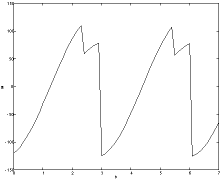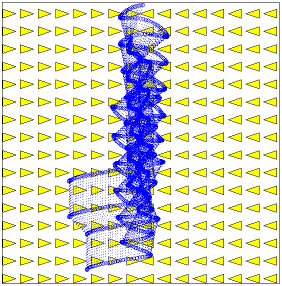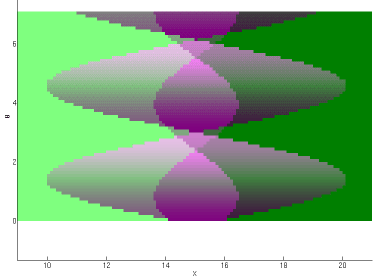 This pathological behavior can be explained by looking at the
turn function, which describes the moment acting on the part
when it is oriented at a specific angle, and positioned
in translational equilibrium.
This pathological behavior can be explained by looking at the
turn function, which describes the moment acting on the part
when it is oriented at a specific angle, and positioned
in translational equilibrium.
 An S-shaped part consisting of four rigidly connected point
contacts does not have a stable equilibrium position when put in a simple
"squeeze" field.
Squeeze fields are force vector fields in which the forces point
perpendicularly towards a center line.
The S-shaped part oscillates without ever reaching equilibrium.
An S-shaped part consisting of four rigidly connected point
contacts does not have a stable equilibrium position when put in a simple
"squeeze" field.
Squeeze fields are force vector fields in which the forces point
perpendicularly towards a center line.
The S-shaped part oscillates without ever reaching equilibrium.
(For the simulation trace shown in this picture,
the part was given a constant velocity in y-direction.
When looking at the postscript picture with a
slow viewer one can see the actual motion.)
 This pathological behavior can be explained by looking at the
turn function, which describes the moment acting on the part
when it is oriented at a specific angle, and positioned
in translational equilibrium.
This pathological behavior can be explained by looking at the
turn function, which describes the moment acting on the part
when it is oriented at a specific angle, and positioned
in translational equilibrium.
The turn function for this part has no root with negative slope, but instead a discontinuity (shown as a vertical line segment). But only roots with negative slope correspond to stable equilibria, in which the moment acts towards restoring equilibrium.
We have shown that only pathological parts with point
contacts have discontiuous turn functions. All polygonal parts
have continuous turn functions, and hence, stable equilibria.
 This picture shows the flow induced by a squeeze field acting on the
S-shaped part from above, in x-theta-space. Notice that for very small and
very large x values, the part experiences a pure translational force.
Only when the part intersects the center line of the squeeze field,
it experiences a moment, visible as arrows with a theta component.
By looking at the full-scale image,
one can see that there are no local attractors (i.e. stable equilibria).
This picture shows the flow induced by a squeeze field acting on the
S-shaped part from above, in x-theta-space. Notice that for very small and
very large x values, the part experiences a pure translational force.
Only when the part intersects the center line of the squeeze field,
it experiences a moment, visible as arrows with a theta component.
By looking at the full-scale image,
one can see that there are no local attractors (i.e. stable equilibria).
 The same flow, shown as a color graph.
Green represents forces in x direction, and magenta represents moments.
Lighter colors denote forces and moments in positive direction,
darker colors denote negative direction.
An equilibrium would be medium gray.
The same flow, shown as a color graph.
Green represents forces in x direction, and magenta represents moments.
Lighter colors denote forces and moments in positive direction,
darker colors denote negative direction.
An equilibrium would be medium gray.